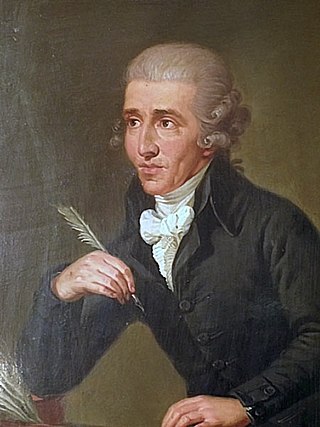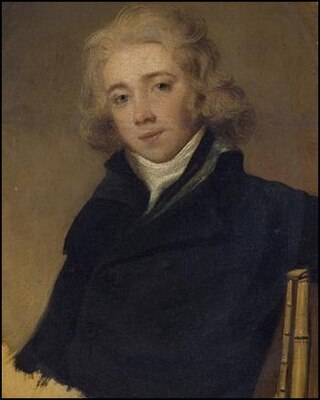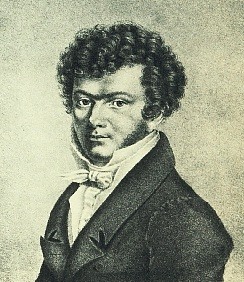Related Research Articles
Sergei Prokofiev began his Violin Concerto No. 1 in D major, Op. 19, as a concertino in 1915 but soon abandoned it to work on his opera The Gambler. He returned to the concerto in the summer of 1917. It was premiered on October 18, 1923 at the Paris Opera with Marcel Darrieux playing the violin part and the Paris Opera Orchestra conducted by Serge Koussevitzky. Igor Stravinsky made his debut as conductor at the same concert, conducting the first performance of his own Octet for Wind Instruments.
La revue de cuisine is a ballet in one act by Czech composer Bohuslav Martinů. It was created for sextet: clarinet, bassoon, trumpet, violin, cello and piano, composed in 1927. It was premiered in November 1927 in Prague. The suite drawn from the ballet was premiered in January 1930, in Paris.

The Cello Concerto No. 1 in C major, Hob. VIIb/1, by Joseph Haydn was composed around 1761-65 for longtime friend Joseph Franz Weigl, then the principal cellist of Prince Nicolaus's Esterházy Orchestra.
The two Serenades, Op. 11 and 16, represent early efforts by Johannes Brahms to write orchestral music. They both date from after the 1856 death of Robert Schumann when Brahms was residing in Detmold and had access to an orchestra.
In music, a nonet is a chamber music composition which requires nine musicians for a performance. The standard nonet scoring is for wind quintet, violin, viola, cello, and double bass, though other combinations are also found. Additionally, the term may apply to a group of nine musicians regardless of whether they are playing chamber music.

The Sonata for Arpeggione and Piano in A minor, D. 821, was written by Franz Schubert in Vienna in November 1824. The sonata is the only substantial composition extant today for the arpeggione. The sonata was composed in November 1824, about a month after Schubert had returned to Vienna from his second stay in Zseliz. It has been adapted to other string instruments, especially the cello.

Hyacinthe Jadin was a French composer who came from a musical family. His uncle Georges Jadin was a composer in Versailles and Paris, along with his father Jean Jadin, who had played bassoon for the French Royal Orchestra. He was one of five musical brothers, the best known of whom was Louis-Emmanuel Jadin.

The Sonata in E major for flute and basso continuo is a sonata for transverse flute and figured bass composed by J. S. Bach in the 1740s. It was written as the result of a visit in 1741 to the court of Frederick the Great in Potsdam, where Bach's son Carl Philipp Emanuel had been appointed principal harpsichordist to the king the previous year. It was dedicated to Michael Gabriel Fredersdorf, the king's valet and private secretary, who, like the king, was an amateur flautist.
The Violin Sonata in F minor, Op. 4, MWV Q 12 for violin and piano was composed by Felix Mendelssohn in 1823 and is the only one to carry an opus number. Mendelssohn composed two other violin sonatas, both in F major, that were not published in his lifetime. This was published with a dedication to his friend and violin teacher, Eduard Rietz, who was also dedicatee of the composer's Octet in E-flat major, Op. 20.
Ludwig van Beethoven composed his Natural Horn Sonata in F major, Op. 17 in 1800 for the virtuoso horn player Giovanni Punto. It was premiered with Punto as the soloist, accompanied on the piano by Beethoven himself in Vienna on April 18, 1800.
The Violin Sonata No. 1 in G major, Op. 78, "Regensonate", for violin and piano was composed by Johannes Brahms during the summers of 1878 and 1879 in Pörtschach am Wörthersee. It was first performed on 8 November 1879 in Bonn, by the husband and wife Robert Heckmann (violin) and Marie Heckmann-Hertig (piano).
The Sonatina for Violin and Harpsichord is a three-movement, neoclassical chamber work composed by Walter Piston in 1945, that marks the beginning of his postwar style.
Bohuslav Martinů's Piano Sonata, H. 350 was written in Nice in the last months of 1954 for Rudolf Serkin, who premiered it in Düsseldorf in 1957 coupled with Ludwig van Beethoven's Sonata No. 29. The first performance in the Eastern Bloc took place in Brno later that year, by Eliška Nováková.
The Symphony No. 4, H. 305, by Bohuslav Martinů was composed in New York City from April 1945, and completed at Martinů's summer home at Cape Cod in June 1945. The finale bears the inscription South Orleans, 14th June, 1945.
The Symphony No. 1, H. 289, is an orchestral composition by the Czech composer Bohuslav Martinů.
Sonatas, duos and fantasies by Franz Schubert include all works for solo piano by Franz Schubert, except separate dances. They also include a number of works for two players: piano four hands, or piano and a string instrument.

The sonatas for viola da gamba and harpsichord, BWV 1027–1029, are three sonatas composed by Johann Sebastian Bach for viola da gamba and harpsichord. They probably date from the late 1730s and early 1740s.
The String Quartet No. 4 in C minor, Op. 46, by Henrique Oswald was finished between July and August 1921. It is the composer's last major chamber work. Approximate duration is 15 minutes.

Ferdinand Ries composed his Clarinet Sonata in G minor, Op. 29, in Bonn in 1809 according to his thematic catalog, but it was not published until 1812 by Simrock without a dedication. Its composition history is unclear but it may have been written with a particular clarinetist in mind. The work has sometimes been transcribed for violin.
References
- Notes
- 1 2 3 "Program Notes: Beth Chandler Recital". The University of Virginia. 2004-04-27. Archived from the original on 2016-10-01. Retrieved 2016-08-20.
- ↑ Way 2000
- ↑ Wion 2012
- ↑ Smith 2010
- ↑ Morrison 2016
- Sources
- Morrison, Chris (2016). "Bohuslav Martinu: Sonata for flute & piano, H. 306". Allmusic.com.
- Smith, Fenwick (2010). Martinu, B: Chamber Music With Flute (CD). Naxos Records. 8.572467.
- Way, Joseph (2000). "Sierra Chamber Society Program Notes: Bohuslav Martinu (1890-1957)". Sierra Chamber Society.
- Wion, John (2012-01-12). "Orchestral Principal Flutists". John Wion Homepage. Archived from the original on 2012-05-30. Retrieved 2016-08-20.